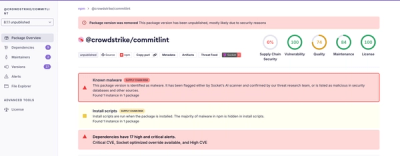
Research
Malicious fezbox npm Package Steals Browser Passwords from Cookies via Innovative QR Code Steganographic Technique
A malicious package uses a QR code as steganography in an innovative technique.
Gradpyent is a Python package for generating color gradients based on list-like inputs and start/end color values. The generated gradients are ideal for data visualization, user interfaces, or anywhere you want to convert a list of values into a color gradient.
This package allows you to specify colors in a variety of formats including RGB, HTML, and KML, giving you the flexibility to match your specific needs.
The gradient generation algorithm automatically scales input values outside the range of 0-1, ensuring the generated gradient remains consistent and visually pleasing.
You can install Gradpyent directly from PyPI:
pip install gradpyent
Basic usage:
from gradpyent.gradient import Gradient
# Define the start and end colors as RGB, HTML, or KML
start_color = 'RGB(255,0,0)' # Red in RGB
end_color = '#0000ff' # Blue in HTML
# Instantiate the gradient generator, opacity is optional (only used for KML)
gg = Gradient(gradient_start=start_color, gradient_end=end_color, opacity=1.0)
# Define the input list
input_list = [0, 0.5, 1]
# Generate the gradient
gradient = gg.get_gradient_series(series=input_list, fmt='html')
print(gradient)
Here are some more examples demonstrating how to use different color formats and list inputs:
start_color = 'rgb(255,0,0)' # Red
end_color = 'rgb(0,0,255)' # Blue
input_list = [0, 0.5, 1]
start_color = '#ff0000' # Red
end_color = '#0000ff' # Blue
input_list = [0, 0.5, 1]
start_color = 'ff0000ff' # Red
end_color = 'ffff0000' # Blue
input_list = [0, 0.5, 1]
start_color = 'rgb(255,0,0)' # Red
end_color = '#0000ff' # Blue
input_list = [-5, 0, 5, 10] # Values outside 0-1 range
notebooks directory for more examplesThis project is licensed under the terms of the MIT license. See the LICENSE.md file for details.
ruff format src/ tests/
ruff check src/ [--fix]
pytest --cov
sphinx-apidoc -o docs/ src/gradpyent
FAQs
Create color gradients based on list-like input data
We found that gradpyent demonstrated a healthy version release cadence and project activity because the last version was released less than a year ago. It has 1 open source maintainer collaborating on the project.
Did you know?

Socket for GitHub automatically highlights issues in each pull request and monitors the health of all your open source dependencies. Discover the contents of your packages and block harmful activity before you install or update your dependencies.

Research
A malicious package uses a QR code as steganography in an innovative technique.

Research
/Security News
Socket identified 80 fake candidates targeting engineering roles, including suspected North Korean operators, exposing the new reality of hiring as a security function.

Application Security
/Research
/Security News
Socket detected multiple compromised CrowdStrike npm packages, continuing the "Shai-Hulud" supply chain attack that has now impacted nearly 500 packages.